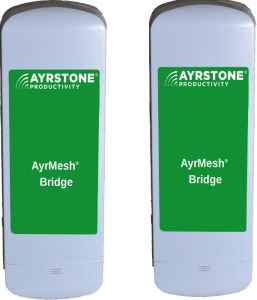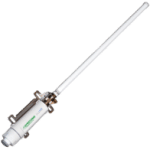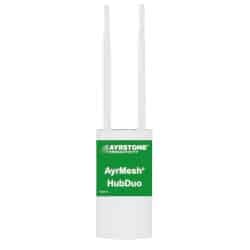The Ayrstone AyrMesh system uses a “mesh” of high-power WiFi boosters (like a WiFi repeater, but easier to set up and maintain) and “Receivers” (allowing non-WiFi devices to join the network) to keep you connected all across your place.
![]()
The WiFi booster or extender is the Ayrstone AyrMesh Hub – a simple, durable outdoor WiFi access point that, mounted up high outside, blasts a WiFi signal that your laptop can use from up to half a mile away.
The Hub actually emits two signals: one is a normal 802.11n WiFi Access Point, to which devices like laptops, tablets, smartphones, WiFi cameras, etc. can connect, and the other is an 802.11s meshing signal, which the Hubs use to communicate between themselves, passing data from one to the other seamlessly.
802.11s meshing is a “Layer 2” mesh, meaning that it extends your existing IP subnet. This means that devices attached to the AyrMesh network (using WiFi or the Ethernet plugs on the Hubs or Receivers) appear as if they are connected directly to your router. They get their IP addresses from your router and can be port-forwarded (made usable from the Internet – see these articles on our blog for more information) just as if they were attached directly to your router.
The Hubs are small but mighty – The Hub2 products (the Hub2x2 and Hub2T deliver about half a watt of power, about 5x what an ordinary indoor WiFi router does. It then uses a high-gain (9 dBi) antenna to “focus” that power out toward the horizon for maximum range, as well as bringing in signals from much lower-power devices – this increases the range of the Hub to about 40x that of a”normal” WiFi device. The HubDuo uses slightly lower power and a lower-gain antenna, but it still provides about 20x a normal WiFi device.
Because of this, the Hub must be mounted up high and in the clear for maximum range – it is generally not suitable for indoor use. Indoor access points use low-gain antennas that send the signal in every direction – including up and down – to better fill an interior space, and they frequently use multiple antennas to make use of “bouncing” signals off of walls, floors, and ceilings.
The first Hub in your system is connected to your router and is called the “Gateway Hub.” Other Hubs are only connected to power (plug power or solar/wind power) and are called “Remote Hubs.” The Ethernet port on the Remote Hubs can be used to connect wired devices or bring the network into buildings – see this article about that.
 There is a special Hub called the AyrMesh Cab Hub2. This is actually just a normal AyrMesh Hub provided with a special magnetic-mount antenna and a cable that allows it to plug into a utility plug (cigarette lighter) in the cab of your truck, tractor, sprayer, combine, or even ATV or utility vehicle.
There is a special Hub called the AyrMesh Cab Hub2. This is actually just a normal AyrMesh Hub provided with a special magnetic-mount antenna and a cable that allows it to plug into a utility plug (cigarette lighter) in the cab of your truck, tractor, sprayer, combine, or even ATV or utility vehicle.
The Cab Hub is designed to connect to the stationary Hubs on your farm so you can have a constant connection to devices from inside the cab of your vehicles. It will quickly join the mesh of any Hub in its range (up to about 2 miles away) and switch between Hubs as you move across your properties. Read more about the Cab Hub on our blog. We also have an article there about using RAM mounts to mount the Cab Hub.
![]() The AyrMesh Receiver is simply an outdoor, directional 802.11n WiFi “client” device. It joins the WiFi network of the Hub at which it is pointed, and provides an Ethernet connection to the network on its Ethernet port. Although it does both receive and transmit data, we called it the “Receiver” because it connects to a WiFi network but does not create a WiFi access point of its own. They can also be considered “WiFi to Ethernet converters” – the radio receives the WiFi from the Hub outside, and the Ethernet cable brings it inside, where you can plug a device into the power supply’s LAN port. That device will then be on the network.
The AyrMesh Receiver is simply an outdoor, directional 802.11n WiFi “client” device. It joins the WiFi network of the Hub at which it is pointed, and provides an Ethernet connection to the network on its Ethernet port. Although it does both receive and transmit data, we called it the “Receiver” because it connects to a WiFi network but does not create a WiFi access point of its own. They can also be considered “WiFi to Ethernet converters” – the radio receives the WiFi from the Hub outside, and the Ethernet cable brings it inside, where you can plug a device into the power supply’s LAN port. That device will then be on the network.
The AyrMesh Receiver is powerful and it has a powerful directional antenna, so it can communicate with the Hub at about 2 miles (or a little more with good line-of-sight and low interference). It is designed to be mounted outside on a pole or a flat surface like a wall. Here’s an article from our blog about the AyrMesh Receiver.
 In response to customer demand, we also introduced the AyrMesh Bridge. The AyrMesh Bridge is a pair of radios (housed in the same outdoor-ready, UV-resistant housings as the AyrMesh Receiver) that use the 5.8 GHz microwave radio band and a special, non-WiFi narrow-band signal. The two radios, mounted so they are pointing at each other, provide a “transparent” wireless bridge – the equivalent of a wireless Ethernet cable. You can plug one of the radios into your network (your router, a Remote Hub, a Receiver, or even another Bridge radio) and whatever is plugged into the other Bridge will appear as if it is plugged directly into the network. The Bridge radios have the same radio power as the Receiver (between a quarter and half a watt), but a more powerful directional antenna (11 dBi). Because of the narrow-band signal they use, they can communicate at up to 5 miles apart. At short distances, they will provide over 30 Mbps of throughput, which will diminish at longer range. At 5 miles, they provide about 5 Mbps of throughput.
In response to customer demand, we also introduced the AyrMesh Bridge. The AyrMesh Bridge is a pair of radios (housed in the same outdoor-ready, UV-resistant housings as the AyrMesh Receiver) that use the 5.8 GHz microwave radio band and a special, non-WiFi narrow-band signal. The two radios, mounted so they are pointing at each other, provide a “transparent” wireless bridge – the equivalent of a wireless Ethernet cable. You can plug one of the radios into your network (your router, a Remote Hub, a Receiver, or even another Bridge radio) and whatever is plugged into the other Bridge will appear as if it is plugged directly into the network. The Bridge radios have the same radio power as the Receiver (between a quarter and half a watt), but a more powerful directional antenna (11 dBi). Because of the narrow-band signal they use, they can communicate at up to 5 miles apart. At short distances, they will provide over 30 Mbps of throughput, which will diminish at longer range. At 5 miles, they provide about 5 Mbps of throughput.
The primary reason customers asked for the bridge is to position a Gateway Hub far from their router, usually on a Grain Leg or on a hill on their property to maximize the range of the Hub. However, they can also be used for simple building-to-building links and to connect non-WiFi devices like high-definition IP cameras that may need more bandwidth than you’d like to take out of the AyrMesh network.
All AyrMesh products are self-configuring, self-updating, and managed through AyrMesh.com. They obtain their initial configuration information by being “initialized” – you connect each device to your router for a few minutes so they can download the configuration information from AyrMesh.com. They are then ready to be deployed, and their configuration is kept up-to-date as they check into AyrMesh.com every five minutes. This way, you can also monitor the devices on AyrMesh.com and see when a device has problems.
For more information, please see the other “How it Works” articles here, as well as our customer support page (which has links to installation slideshows, videos, and FAQ pages), and the Questions section on Ayrstone.com


